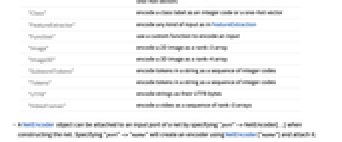NetEncoder["name"]
represents an encoder that takes a given form of input and encodes it as an array for use in a net.
NetEncoder[{"name",…}]
represents an encoder with additional parameters specified.


NetEncoder
Listing of Net Encoders »NetEncoder["name"]
represents an encoder that takes a given form of input and encodes it as an array for use in a net.
NetEncoder[{"name",…}]
represents an encoder with additional parameters specified.
Details


- NetEncoder[…][input] gives the specified encoding for input.
- NetEncoder[…][{input1,input2, …}] explicitly computes outputs for each of the inputi.
- When given a NumericArray as input, the output will be a NumericArray.
- Possible named encoders include:
-
"Audio" encode audio as a sequence of waveform amplitudes "AudioMelSpectrogram" encode audio as a mel spectrogram "AudioMFCC" encode audio as a sequence of MFCC vectors "AudioSpectrogram" encode audio as a spectrogram "AudioSTFT" encode audio as a sequence of Fourier transforms "Boolean" encode True and False as 1 and 0 "Characters" encode characters in a string as a sequence of integer codes or one-hot vectors "Class" encode a class label as an integer code or a one-hot vector "FeatureExtractor" encode any kind of input as in FeatureExtraction "Function" use a custom function to encode an input "Image" encode a 2D image as a rank-3 array "Image3D" encode a 3D image as a rank-4 array "SubwordTokens" encode tokens in a string as a sequence of integer codes "Tokens" encode tokens in a string as a sequence of integer codes "UTF8" encode strings as their UTF8 bytes "VideoFrames" encode a video as a sequence of rank-3 arrays - A NetEncoder object can be attached to an input port of a net by specifying "port"->NetEncoder[…] when constructing the net. Specifying "port"->"name" will create an encoder using NetEncoder["name"] and attach it.
- When NetTrain is allowed to automatically attach a loss layer and a NetDecoder is attached to the output of the net, a NetEncoder of the same type will be created for the "Target" input of the loss layer.
- If the input to a NetEncoder is already in the correct form, the NetEncoder will be bypassed—that is, applying a NetEncoder twice has no effect.
- NetEncoder[NetDecoder[…]] will create an encoder based on the parameters of an existing decoder.
Examples
open all close allBasic Examples (1)
Scope (1)
An encoder can be attached to the input port of a net. First, create an encoder:
Attach the encoder to the input of an ElementwiseLayer:
Properties & Relations (3)
Attaching an encoder ensures that the sizes of all parameters and inputs can be inferred:
A specific size of array can also be specified, without using an encoder:
NetTrain will automatically try to attach an encoder when a net is not fully specified. Automatic attachment of a class encoder:
Automatic attachment of an image encoder:
Applying a NetEncoder a second time is a no-op:
See Also
Tech Notes
Text
Wolfram Research (2016), NetEncoder, Wolfram Language function, https://reference.wolfram.com/language/ref/NetEncoder.html (updated 2022).
CMS
Wolfram Language. 2016. "NetEncoder." Wolfram Language & System Documentation Center. Wolfram Research. Last Modified 2022. https://reference.wolfram.com/language/ref/NetEncoder.html.
APA
Wolfram Language. (2016). NetEncoder. Wolfram Language & System Documentation Center. Retrieved from https://reference.wolfram.com/language/ref/NetEncoder.html
BibTeX
@misc{reference.wolfram_2025_netencoder, author="Wolfram Research", title="{NetEncoder}", year="2022", howpublished="\url{https://reference.wolfram.com/language/ref/NetEncoder.html}", note=[Accessed: 03-January-2026]}
BibLaTeX
@online{reference.wolfram_2025_netencoder, organization={Wolfram Research}, title={NetEncoder}, year={2022}, url={https://reference.wolfram.com/language/ref/NetEncoder.html}, note=[Accessed: 03-January-2026]}